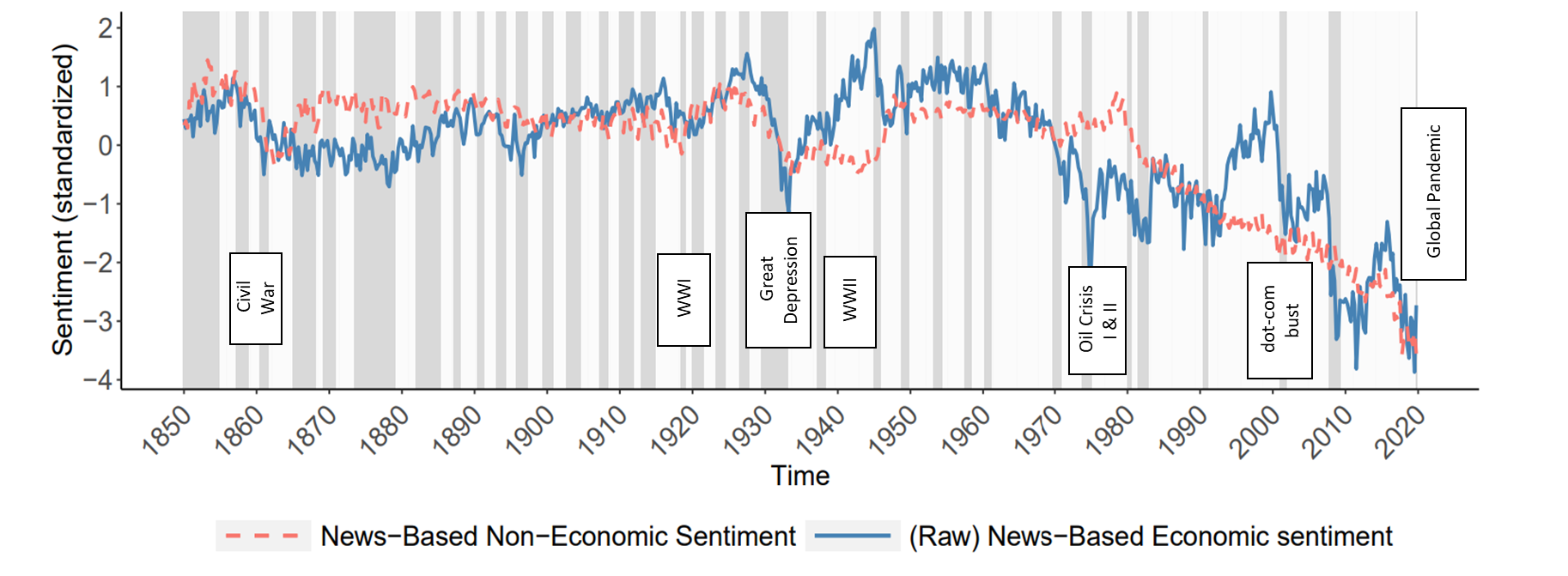The Doom Loop
If it bleeds it leads. This media cliche begs the question, is the media feeding us negativity we swallow like bad medicine or are they giving us a spoonful of our preferred elixir?
The Russian news site, City Reporter, did an experiment for an entire day publishing nothing but positive stories. The result? They lost two-thirds of their normal readership that day.
Other research shows that for a headline of average length, each additional negative word increases click-through by 2.3%.
But has it always been this way? In a recent, working paper (findable on SSRN) researchers compiled a massive dataset of 170 years of digitized newspapers from 13,000 local newspapers constituting about 1 billion articles. Their aim was seeing how well sentiment predicts economic outputs, e.g. GDP. It turns out media sentiment is a very good predictor (and reflector) of economic outcomes.
But that’s not why I’m sharing this. Check out this trend data parsing economic article sentiment from non-economic over 170 years of US history. I added in a few of the seminal events.
Notice anything? How about the long fall off the negative sentiment cliff for economic and non-economic since 1998 and 78′ respectively? How is it that our media sentiment is so much worse over this recent history? A Civil War, two World Wars and a Great Depression ain’t nothing in the annals of crappy.
Notice also the gray bars, each of which marks an official recession; many more and wider in the first 80 years. There was a lot more reason for economic gloom and doom during this stretch and yet it was rainbows and unicorns compared to more recent eras. 
What gives? In a word, competition. The proliferation of media outlets and the 24hr news cycle all playing to the lowest common denominator, a myopic click-through race to the bottom. If negative “works” then give me a double, triple…octuple dose because more negative must be better, right?
What’s the fundraising point to all this?
- Don’t follow, lead.
- Good luck selling a doom story into a doom vortex that’s exponentially more powerful than yours because it already includes your gloom story plus a billion other ones.
- Sell hope if you dare, sell promise and uplift if you’ve got conviction in the good you’re doing
- People aren’t motivated by fear or guilt or even anger or aspiration. It’s not that simple. They’re motivated to reinforce their values and goals and feel psychologically satisfied. Nothing about that formula requires or even benefits from the doom loop.
Kevin



That’s very interesting, Kevin — thank you.
My amateur understanding is that the chart also correlates to how much people in the U.S. participate in organized religion. My hunch is that has more to do with it than media competition, though I could be convinced the decline in religion is the effect of negative media sentiments, not the cause.
If you’ll grant me that many faiths lead their adherents to see a brighter side to current events, that raises interesting questions. For religious charities, how to use marketing copy to keep that faith/hope alive. For secular charities, what they might tap into about religious archetypes — the roles of their leaders, of rituals, of origin stories — to describe their own charity’s history, staff, and governance.
Hi John, thanks for reading and commenting. Religious participation has certainly fallen off pretty dramatically since the 80s, which does match the chart trendline. And religious people, on average, report being happier and more satisfied than non-religious folks.
But since this is media sentiment, not public/reader, that would mean one of two things or perhaps both. The press is a mirror, merely reflecting our collective mood and we got less happy over time as we became less religious, so the press accommodated by reporting on upticks in crappy stuff (e.g. crime). Or the press is also us and they too became less religious, less happy and this sourer sentiment manifested in their writing/reporting proclivities. Or both.
Like all socio-economic and societal trends, it’s probably multi-faceted and complicated. I could imagine the secularization of US society was cause and effect of media negativity but would still posit that their business model of eyeballs and clicks and the 24-hour feeding frenzy with competitive pressures galore also fed a downward spiral of negativity as what “works” got defined downward. It all came full circle and started eating itself with media quality, trust and stature taking big hits over time.
We do quite a bit of work with religious charities and very much agreed that there is a (growing) segment of people with religious “roots” (cultural, heritage) that are looking for ways to reflect and support their religious Identity that don’t involve tithing, attendance, etc.
I’m also surprised when secular charities dismiss the success of religious charities with circular logic of “yeah, well they’re religious”. There is a lot of performance variance within the religious charity world and in our experience, the ones that have strong growth are the ones that own their religious brand with zero ambivalence, it feeds all that they do – hiring, business investment, program, messaging, etc. The less successful or struggling religious charities are no different than the less successful or struggling secular ones with internal strife, ambivalence about who they are, no shared purpose, no North Star, etc.